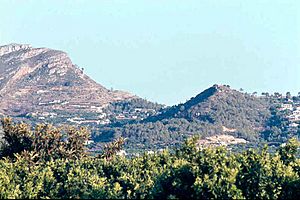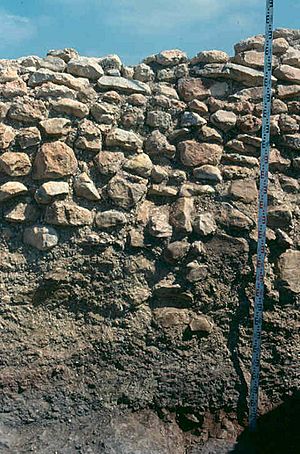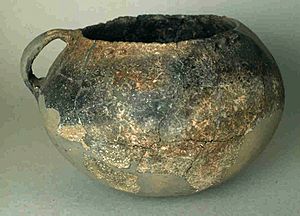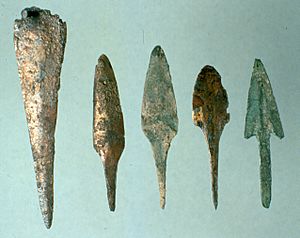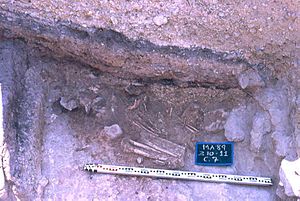Muntanya Assolada facts for kids
Muntanya Assolada is an ancient village from the Bronze Age. It is located in Alzira, Valencia, Spain. This settlement was built on a high point of the Corbera mountains. It overlooks the Xúquer river plain from about 227 metres (745 ft) above sea level.
Archaeologists started digging here in 1978. Bernat Martí Oliver led the first digs. Work continued until 1996 and then started again in 2004. Later, Rosa Enguix Alemany and María Jesús de Pedro also helped lead the excavations.
Today, the excavated area is about 700 square metres (7,500 sq ft). It shows many old structures. These include a main street and rectangular rooms on both sides. There is also a strong wall, about two meters wide and almost three meters high (6.6 × 9.8 ft). The site also shows signs of daily life, like places where animals were kept. The slopes were also flattened to make more space for the village.
The Alzira City Council now owns the site. The Servei d'Investigació Prehistòrica is working to make the excavated buildings stronger. They also want to add signs so visitors can explore the site.
A nearby burial cave shows that natural caves were used as burial places. Also, one person was found buried in a pit inside the village area. The items found at Muntanya Assolada show that people lived here for a long time. This period stretches from the Early Bronze Age to the Late Bronze Age.
Contents
Where is Muntanya Assolada?
The Bronze Age village of Muntanya Assolada is on the right side of the Xúquer river. It sits on a high part of the Corbera mountain range. This spot is west of Tallat Roig, between the Murta and Aixavegó ravines. From here, it looks over the river plain from 227 metres (745 ft) up.
The name "Muntanya Desolada" means "Deserted Mountain." This name came after a part of the mountain top collapsed. This happened on the night of October 24–25, 1783. Before this event, the place was known as Muntanya de la Font del Baladre.
What Did Archaeologists Find?
The Servei d'Investigació Prehistòrica started digging at Muntanya Assolada in 1978. They worked until 1996 and then again from 2004. The area they have dug up is over 700 m2 (7,500 sq ft).
This area shows different room structures. There are signs of various activities that happened here. For example, there are layers of soil from when people lived there. There are also signs of times when the village was left empty. Fire was found in some areas, possibly from burning materials where animals were kept. The slopes were also leveled to make the village bigger over time.
At the top part of the site, you can see a central street. There are rooms on both sides of this street. In one room, archaeologists found an oven. This oven was likely used for baking bread or toasting grains. Another room has stone steps at its entrance.
A strong wall surrounds the site. It is almost two meters wide and stands three meters high (6.6 × 9.8 ft). This wall was built on a terraced summit. The terraces were made with solid stone and clay buildings. This helped to extend the village down the slope.
Archaeologists found different layers of occupation. This means people lived here for a long time. Some structures were quickly filled in to build new ones. This suggests the village was continuously lived in throughout the Bronze Age.
What Objects Were Found?
The objects found at Muntanya Assolada are kept at the Museu de Prehistòria de València.
- Pottery: There are many types of pottery. These include cups, bowls, pots, and large storage jars. Some have special shapes like "fairing" or "geminated" vessels. There are also spoons. The pottery has decorations like lines, dots, and shiny surfaces.
- Metal Objects: Metal items include tools for engraving, arrowheads, a dagger, and a chisel. There are also signs of metalworking, like slag (waste from melting metal), a stone hammer, and a ceramic crucible (a pot for melting metal).
- Stone Tools: Many stone tools were found. These include sickles and arrowheads made of flint. There are also polished stone tools and many pieces left over from making stone tools.
- Bone Tools: Tools made from bone include engravers, spatulas, and chisels. A ring and different ivory buttons were also found.
The animal bones found show that this was a farming village. Sheep and goats were the most common animals. Oxen were used for pulling things and for meat and milk. Pigs were also raised. Remains of horses and dogs were found too. Hunting deer suggests there were many trees and plants around.
A group of animal bones from a lower layer was dated. This layer was between the upper wall and another structure. The dating showed these bones are from between 1890 BC and 1690 BC.
Burials at the Site
People were buried at Muntanya Assolada. A small burial cave was found very close to the village. It was on the southeast side of the cliff. This cave held the remains of at least four people. It also had animal bones and some grave goods (items buried with the dead).
Another burial was found on the western side of the southern slope. It was in a round grave, more than two meters (6.6 feet) deep. The person was buried in a curled-up position. Their legs were folded, and feet crossed. The right arm was behind the back, and a stone block crushed the hand. The left arm was bent in front of the body. The hand was under the face. Most of the skull was missing. Scientists used C-14 dating on this person. It showed they lived between 2210 BC and 2130 BC.
Why is Muntanya Assolada Important?
Muntanya Assolada is seen as a typical village from the Valencian Bronze Age. This is because of the pottery designs and the old stone tools. The copper metalwork and the burial cave also show this.
The village was lived in until the Late Bronze Age. This is known from certain types of pottery found. These include vessels with a wide opening and flat bases. Also, real bronze objects were found from this later period. The types of pottery at Muntanya Assolada are common for Bronze Age villages in Valencia. However, in the highest layers, more advanced pottery shapes were found.
The two dates found from the site (from animal bones and a human burial) fit with a timeline. This timeline goes from the Early Bronze Age to the Late Bronze Age. Muntanya Assolada and other nearby sites show that this area was continuously settled. People lived here from the Bronze Age all the way to the Iberian Culture period. This means the Ribera del Xúquer area was always occupied.
The site was abandoned around the end of the Middle Bronze Age or Late Bronze Age. People then moved to settlements on the plain. Later, during the Iron Age, people moved to L'Alteret de la Vintihuitena of Albalat. Finally, with the arrival of the Iberian Culture, they moved to the slopes of the highest hills.
Images for kids
See also
 In Spanish: Muntanya Assolada para niños
In Spanish: Muntanya Assolada para niños


